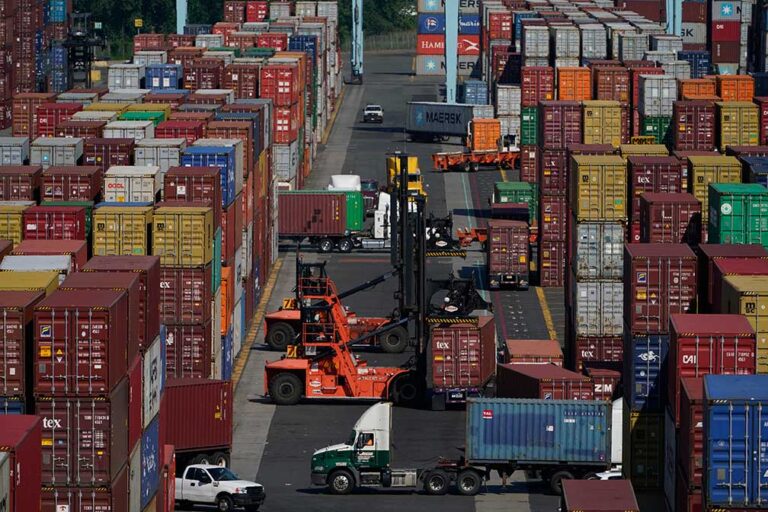November saw declines in truckload volumes, according to information received from DAT Freight and Analytics — but with sound reason.
“Shippers moved so much freight into the U.S. earlier this year, ahead of potential tariffs and port strikes, that we didn’t see the volumes we might expect in November,” said Ken Adamo, DAT’s chief of analytics.
President-elect Donald J. Trump has threatened tariffs on goods from several countries, including Canada and Mexico, but actual implementation won’t happen until after the Jan. 20 presidential inauguration. Both Canada and Mexico are attempting to comply with Trump’s demands to tighten border security, which could cause Trump to relent on tariff threats.
The port strikes Adamo refers to were settled, at least temporarily.
Earlier in the fall, ports along the U.S. East and Gulf coasts that are administered by the U.S. Maritime Alliance (USMX), were under threat of a strike by the International Longshoremen’s Association (ILA), the largest maritime worker’s union in North America. Many businesses ordered extra inventory in August and September in anticipation of the strikes, which were expected to cause massive disruptions in the U.S. economy.
The two sides came to a tentative agreement after just three days and the ports reopened, but the settlement is effective only until Jan. 15, 2025 — when another strike looms.
Freight rates saw some improvement.
Freight rates were, overall, slightly better in November, according to DAT.
Dry van spot rates, on average, remained at $2.02 per mile, identical to October rates, but have since climbed in December. Refrigerated rates were up by six cents to $2.45 in November, while flatbed rates dropped by four cents to $2.42 per mile. The $2.45 refrigerated spot rate was the highest average since January. Overall, rates are up about 5% compared to November of 2023.
On the contract side, rates didn’t change much from October. Contract van rates were down eleven cents from November 2023, refrigerated rates were down by eighteen cents and flatbed down eleven cents. However, DAT’s New Rate Differential (NRD), which measures changes in the contract market, was positive for the third consecutive month. That means that new contracts being entered are better than old contracts that are expiring.
Private fleets have impacted the freight market.
ACT Research’s For-Hire Trucking Index for Volumes was in positive territory for the second consecutive month in November.
“The U.S. economy remains resilient, and freight volumes are growing,” the release noted. ACT’s Capacity Index came in at 50, indicating a balance between the supply of available trucks and the demand for them. The release also pointed to the expansion of private fleets as a key factor in slowing freight rate recovery.
Private fleets have been in the news for most of 2024 as product manufacturers continue to buy trucks. Proctor & Gamble, for example, had no private fleet when it began purchasing trucks in 2019. Today, the fleet accounts for over 800 drivers. The freight handled by those 800 drivers is no longer available to for-hire carriers — and P&G certainly isn’t the only private fleet.
The Cass Freight Index for Shipments showed a 2.8% seasonally adjusted gain in November, while the index for expenditures grew by 3.1%. More freight, and more income for hauling it, are positive signs for the trucking industry.
The Cass report also focuses on the increase in private fleets as a drag on the for-hire market. The release predicts that the total Freight Index decline for 2024 will be about 4%, while private fleets have grown roughly 5%.
These factors could impact freight volumes and rates.
While rates are generally predicted to grow slowly in 2025, there are several factors that could impact freight volumes and rates.
One is inflation, which typically grows when a new administration takes over the U.S. government.
The Federal Reserve board on Dec. 18 announced another .25 point cut to its key interest rate, an indication that inflation is slowing. The group also announced it expects to cut rates twice more in 2025, rather than the four cuts previously expected. If the rate cuts aren’t enough to curb inflation, as some analysts predict, the economy could suffer.
A second factor that could drive inflation and reduce freight volumes is the threat of tariffs.
If Trump imposes tariffs on China, Canada and Mexico, as he has threatened, imports could be slowed and the cost of products will rise. Trump has used threats of tariffs in the past as a tool to gain concessions from other countries, which may be a component of his current threats.
The threat of a port strike looms once again.
The largest near-term headwind to the freight market may be the looming threat of Jan. 15 port strikes.
More than half of the nation’s imports flow through the East and Gulf coast ports. The ILA and USMX settled some issues during the three-day October stoppage when the USMX agreed to pay and benefits increases, but other issues remain.
One of those issues is modernization.
U.S. ports have been classified as “inefficient” compared with ports in other parts of the world. The World Bank Group claims that ports in other countries are 40% more productive than U.S. ports; in fact, no U.S. ports are listed among the world’s Top 50.
Increased use of automation would help them become more efficient, but at the cost of jobs. The ILA is insisting that plans to modernize U.S. ports be eliminated, claiming that U.S. port efficiency ratings are skewed by customs clearance and extensive safety and security protocols mandated by U.S. law.
On December 12, president-elect Trump met with ILA Executive Vice Presidents Harold J. and Dennis A. Daggett at Trump’s Mar-a-Lago resort.
After the meeting, Trump posted to Truth Social, “There has been a lot of discussion having to do with ‘automation’ on United States docks. I’ve studied automation and know just about everything there is to know about it. The amount of money saved is nowhere near the distress, hurt and harm it causes for American Workers, in this case, our Longshoremen.”
In September, JP Morgan Chase estimated that an ILA strike would cost the economy $3.8 to $4.5 billion per day. That cost will be even higher in January. With a determined ILA and a sympathetic incoming U.S. president, it’s looking like a strike will occur, and it likely won’t be resolved quickly.
Meanwhile, the trucking industry does what it always does: Transport cargo across the continent as quickly and safely as possible.
Cliff Abbott is an experienced commercial vehicle driver and owner-operator who still holds a CDL in his home state of Alabama. In nearly 40 years in trucking, he’s been an instructor and trainer and has managed safety and recruiting operations for several carriers. Having never lost his love of the road, Cliff has written a book and hundreds of songs and has been writing for The Trucker for more than a decade.








